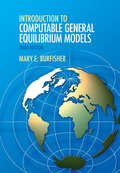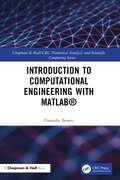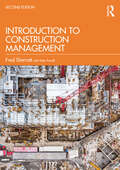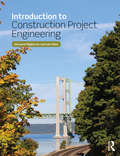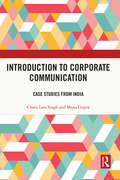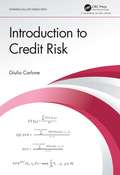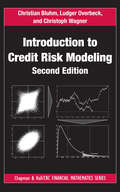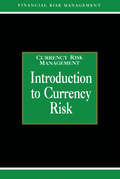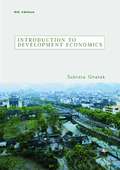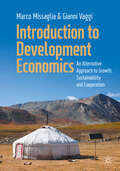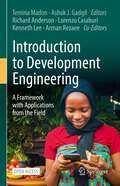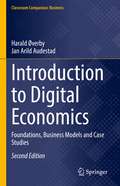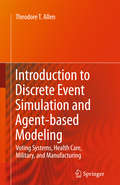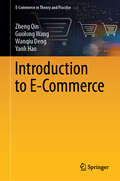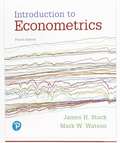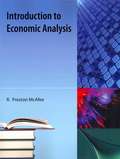- Table View
- List View
Introduction to Computable General Equilibrium Models
by Mary E. BurfisherComputable general equilibrium (CGE) models are widely used by governmental organizations and academic institutions to analyze the economy-wide effects of events such as climate change, tax policies and immigration. This book provides a practical, how-to guide to CGE models suitable for use at the undergraduate college level. Its introductory level distinguishes it from other available books and articles on CGE models. The book provides intuitive and graphical explanations of the economic theory that underlies a CGE model and includes many examples and hands-on modeling exercises. It may be used in courses on economics principles, microeconomics, macroeconomics, public finance, environmental economics and international trade and finance, because it shows students the role of theory in a realistic model of an economy. The book is also suitable for courses on general equilibrium models and research methods and for professionals interested in learning how to use CGE models.
Introduction to Computable General Equilibrium Models
by Mary E. BurfisherComputable general equilibrium (CGE) models play an important role in supporting public-policy making on such issues as trade, climate change and taxation. This significantly revised volume, keeping pace with the next-generation standard CGE model, is the only undergraduate-level introduction of its kind. The volume utilizes a graphical approach to explain the economic theory underlying a CGE model, and provides results from simple, small-scale CGE models to illustrate the links between theory and model outcomes. Its eleven hands-on exercises introduce modelling techniques that are applied to real-world economic problems. Students learn how to integrate their separate fields of economic study into a comprehensive, general equilibrium perspective as they develop their skills as producers or consumers of CGE-based analysis.
Introduction to Computational Engineering with MATLAB® (Chapman & Hall/CRC Numerical Analysis and Scientific Computing Series)
by Timothy BowerIntroduction to Computational Engineering with MATLAB® aims to teach readers how to use MATLAB programming to solve numerical engineering problems. The book focuses on computational engineering with the objective of helping engineering students improve their numerical problem-solving skills. The book cuts a middle path between undergraduate texts that simply focus on programming and advanced mathematical texts that skip over foundational concepts, feature cryptic mathematical expressions, and do not provide sufficient support for novices.Although this book covers some advanced topics, readers do not need prior computer programming experience or an advanced mathematical background. Instead, the focus is on learning how to leverage the computer and software environment to do the hard work. The problem areas discussed are related to data-driven engineering, statistics, linear algebra, and numerical methods. Some example problems discussed touch on robotics, control systems, and machine learning.Features: Demonstrates through algorithms and code segments how numeric problems are solved with only a few lines of MATLAB code Quickly teaches students the basics and gets them started programming interesting problems as soon as possible No prior computer programming experience or advanced math skills required Suitable for students at undergraduate level who have prior knowledge of college algebra, trigonometry, and are enrolled in Calculus I MATLAB script files, functions, and datasets used in examples are available for download from http://www.routledge.com/9781032221410.
Introduction to Construction Contract Management
by Brian GreenhalghThis book is an introduction to construction contract administration and management, covering the delivery and execution stage of a construction project and the various issues which the contract administrator needs to proactively manage. It can therefore be used as a contract administrator’s resource book covering what needs to be done (and why) to keep a construction project on track from a commercial and contractual perspective. It is particularly appropriate for students and new practitioners from varied construction professions and whilst it covers domestic (UK) projects, it will be particularly useful for those studying and working on international projects where terminology, procedures and legal systems may differ from the UK. The content is split into four parts and is subdivided into easy-to-read chapters replicating the timeline of a project during the construction stage: Part A covers initiating the construction stage, project delivery mechanisms, contract administration and health and safety management; Part B covers managing the construction stage, contractor performance and relationship management; Part C covers finalising the construction stage, project completion and close-out; Part D covers claims and disputes. Introduction to Construction Contract Management will be particularly useful for students enrolled on global construction programmes together with international distance learning students and non-cognate graduates starting out on an international career in construction contract administration and quantity surveying.
Introduction to Construction Management
by Fred SherrattIntroduction to Construction Management, Second Edition, is the beginner’s guide to key concepts, terms, processes and practices associated with modern construction management. The new edition has been fully updated with new data, case studies and enhancements and remains the most practical and accessible book on the subject available. Significant new topics have been added including construction ethics, coverage of mental health and wellbeing in the industry, project delivery and Construction 4.0, to make this the most cutting-edge book available for students on construction and engineering management courses. Supported by diagrams, illustrations and case studies, the book starts with a general introduction to the industry and covers the relevant management theory before providing applied coverage of: Production management Commercial management Quality management Health and Safety management Environmental management This is the most approachable text available for anyone starting to learn about construction management at any level.
Introduction to Construction Project Engineering
by Len Holm Giovanni C. MigliaccioThis new textbook fills an important gap in the existing literature, in that it prepares construction engineering and built environment students for their first experience of the jobsite. This innovative book integrates conceptual and hands-on knowledge of project engineering to introduce students to the construction process and familiarize them with the procedures and activities they need to operate as project engineers during their summer internships and immediately after graduation. The textbook is structured into four sections: Section A: Introductory Concepts Section B: Field Engineering Section C: Office Engineering Section D: Advanced Project Engineering The emphasis on field tasks and case studies, questions, and exercises taken from across civil works and commercial building sectors makes this the ideal textbook for introductory to intermediate courses in Construction Engineering, Construction Engineering Technology, Civil and Architectural Engineering, and Construction Management degree programs.
Introduction to Contracts, Sales and Product Liability
by Jethro K. Lieberman Don Mayer Daniel M. Warner George J. SiedelMayer, Warner, Siedel and Lieberman's Introduction to Contracts, Sales and Product Liability is an up-to-date textbook that includes legal issues that are covered in an introductory business law course. The text is organized to permit instructors to tailor the materials to their particular approach. The authors take special care to engage students by relating law to everyday events with their clear, concise and readable style.
Introduction to Corporate Communication: Case Studies from India
by Charu Lata Singh Mona GuptaThis book examines the evolution of corporate communication in the recent past in the context of the rapidly changing contemporary business environment in India. Using several case studies, it illustrates the growing need for small and large businesses to recognize and form a direct connection with their stakeholders and further explains the effective ways through which specific business requirements are realized by communication managers. The book explores the greater dependency and function of multiple media strategies and their challenges. It also offers various theoretical and practical insights into the successful integration of diverse communication and marketing strategies like employee communication, investor relations, corporate social responsibility and philanthropy, branding, crisis management, and corporate ethics and governance, among others. Lucid and comprehensive, this book will be an essential read for students and scholars of corporate communications, business management, media and communication studies, public relations, and marketing, as well as communication and marketing practitioners.
Introduction to Cost-Accounting Systems
by Jacob Cohen David F. HawkinsIntroduces traditional cost accounting systems.
Introduction to Credit Risk
by Giulio CarloneIntroduction to Credit Risk focuses on analysis of credit risk, derivatives, equity investments, portfolio management, quantitative methods, and risk management. In terms of application, this book can be used as an important tool to explain how to generate data rows of expected exposure to counterparty credit risk. The book also directs the reader on how to visualize, in real time, the results of this data, generated with a Java tool. Features Uses an in-depth case study to illustrate multiple factors in counterparty credit risk exposures Suitable for quantitative risk managers at banks, as well as students of finance, financial mathematics, and software engineering Provides the reader with numerous examples and applications Giulio Carlone has an MBA, a PhD, and a Master’s degree in Computer Science from the University of Italy. He is a member of the software system engineering staff of the Department of Computer Science at University College London. He has 20 years of practical experience in technical software engineering and quantitative finance engineering in the commercial sector. His research interests include the use of communication strategies and the implementation of plans and projects using financial software for requirement specifications, requirements analysis, and architectural design.
Introduction to Credit Risk Modeling (Chapman and Hall/CRC Financial Mathematics Series)
by Ludger Overbeck Christoph Wagner Christian BluhmContains Nearly 100 Pages of New MaterialThe recent financial crisis has shown that credit risk in particular and finance in general remain important fields for the application of mathematical concepts to real-life situations. While continuing to focus on common mathematical approaches to model credit portfolios, Introduction to Credit Risk Modelin
Introduction to Currency Risk: Currency Risk Management (Glenlake Series in Risk Management)
by Brian CoyleFirst Published in 2001. Routledge is an imprint of Taylor & Francis, an informa company.
Introduction to Decision Making
by Francis J. AguilarDescribes the process of decision making (establish objectives, generate alternatives, and so on) emphasizing the human side of it (using rules of thumb, favoring one's own pet projects) yet demonstrating the role an analytic/quantitative contribution has to make.
Introduction to Derivative Instruments
by W. Carl Kester Kendall BackstrandProvides an elementary introduction to three major classes of derivative instruments: options, forwards and futures, and swaps.
Introduction to Design Theory: Philosophy, Critique, History and Practice
by Jonathan Ventura Michalle GalIntroduction to Design Theory introduces a comprehensive, systematic, and didactic outline of the discourse of design. Designed both as a course book and a source for research, this textbook methodically covers the central concepts of design theory, definitions of design, its historical milestones, and its relations to culture, industry, body, ecology, language, society, gender and ideology. Demonstrated by a shift towards the importance of the sociocultural context in which products are manufactured and embedded, this book showcases design theory as an emerging sub-discipline of design, unique in its practice-based approach and its broad perception of design. It offers an in-depth understanding of the central concepts, such as "form" and "function", "theory" and "practice", through a discussion of key case studies and historical examples, such as the advent of the view of design in antiquity, the introduction of mass production to modernist design or the ideological shifts in design in the mid-twentieth century, as well as analytical tools for further dissection and learning in practice. With a focus on a combination of several theoretical knowledge foundations — aesthetics and philosophy, critical theories, cultural studies, design history and design anthropology — the reader is enabled to approach design as a central pivot around which contemporary culture revolves, reflecting, reaffirming or challenging social and cultural structures. Aimed towards undergraduate and postgraduate students, as well as teachers and scholars, from across the design disciplines, Introduction to Design Theory invites readers to engage with design from an interdisciplinary perspective, departing from the traditional academic compartmentalisation of practice, history and philosophy.
Introduction to Development Economics
by John Ward-SmithCharged with analyzing and criticizing the way economies develop and grow, development economists play a vital role in attempting to reduce inequality across the world. The fourth edition of this classic textbook introduces students to this vital field. All of the popular aspects of earlier editions are retained with new additions such as the intro
Introduction to Development Economics: An Alternative Approach to Growth, Sustainability and Cooperation
by Gianni Vaggi Marco MissagliaThis textbook provides an introduction to development economics that examines both the drivers of economic growth and sustainable development. It initially presents development economics within a historical and political context, before widening its attention to theories of growth and development, the importance of the Sustainable Development Goals, the imbalance of power between the Global North and South, global development policies, and the role of international finance in development. Rather than focusing primarily on neoclassical growth theories, qualitative and quantitative aspects of the development process are both highlighted. This book aims to give readers a broad understanding of the economic drivers of development and the economic theories that underpin them. It will be relevant to undergraduate and postgraduate students interested in development economics and sustainable development.
Introduction to Development Engineering: A Framework with Applications from the Field
by Richard Anderson Kenneth Lee Temina Madon Ashok J. Gadgil Lorenzo Casaburi Arman RezaeeThis open access textbook introduces the emerging field of Development Engineering and its constituent theories, methods, and applications. It is both a teaching text for students and a resource for researchers and practitioners engaged in the design and scaling of technologies for low-resource communities. The scope is broad, ranging from the development of mobile applications for low-literacy users to hardware and software solutions for providing electricity and water in remote settings. It is also highly interdisciplinary, drawing on methods and theory from the social sciences as well as engineering and the natural sciences.The opening section reviews the history of “technology-for-development” research, and presents a framework that formalizes this body of work and begins its transformation into an academic discipline. It identifies common challenges in development and explains the book’s iterative approach of “innovation, implementation, evaluation, adaptation.” Each of the next six thematic sections focuses on a different sector: energy and environment; market performance; education and labor; water, sanitation and health; digital governance; and connectivity. These thematic sections contain case studies from landmark research that directly integrates engineering innovation with technically rigorous methods from the social sciences. Each case study describes the design, evaluation, and/or scaling of a technology in the field and follows a single form, with common elements and discussion questions, to create continuity and pedagogical consistency. Together, they highlight successful solutions to development challenges, while also analyzing the rarely discussed failures. The book concludes by reiterating the core principles of development engineering illustrated in the case studies, highlighting common challenges that engineers and scientists will face in designing technology interventions that sustainably accelerate economic development.Development Engineering provides, for the first time, a coherent intellectual framework for attacking the challenges of poverty and global climate change through the design of better technologies. It offers the rigorous discipline needed to channel the energy of a new generation of scientists and engineers toward advancing social justice and improved living conditions in low-resource communities around the world.
Introduction to Digital Economics: Foundations, Business Models and Case Studies (Classroom Companion: Business)
by Harald Øverby Jan Arild AudestadInnovations and developments in technology have laid the foundations for an economy based on digital goods and services—the digital economy. This book invites students and practitioners, to take an in-depth look at the impact that technological innovations such as social media, cryptocurrencies, crowdsourcing, and even online gaming is having on today’s business landscape. Learn about the various business models available for the digital economy, including the business models used by Bitcoin, Spotify, Wikipedia, World of Warcraft, Facebook, and Airbnb. This book details the evolution of contemporary economics within the digital stratosphere and highlights the complex ecosystem that makes up the field of digital economics. The foundational text with case studies is also peppered with anecdotes on the various technological innovations which have shaped markets throughout history. The authors provide several models and tools that are essential for analysis, as well as activities that will allow the reader to reflect, analyze, and apply the knowledge and tools presented in each chapter. Introduction to Digital Economics is a definitive guide to the complexities and nuances of this burgeoning and fascinating field of study.
Introduction to Discrete Event Simulation and Agent-based Modeling
by Theodore T. AllenDiscrete event simulation and agent-based modeling are increasingly recognized as critical for diagnosing and solving process issues in complex systems. Introduction to Discrete Event Simulation and Agent-based Modeling covers the techniques needed for success in all phases of simulation projects. These include: * Definition - The reader will learn how to plan a project and communicate using a charter. * Input analysis - The reader will discover how to determine defensible sample sizes for all needed data collections. They will also learn how to fit distributions to that data. * Simulation - The reader will understand how simulation controllers work, the Monte Carlo (MC) theory behind them, modern verification and validation, and ways to speed up simulation using variation reduction techniques and other methods. * Output analysis - The reader will be able to establish simultaneous intervals on key responses and apply selection and ranking, design of experiments (DOE), and black box optimization to develop defensible improvement recommendations. * Decision support - Methods to inspire creative alternatives are presented, including lean production. Also, over one hundred solved problems are provided and two full case studies, including one on voting machines that received international attention. Introduction to Discrete Event Simulation and Agent-based Modeling demonstrates how simulation can facilitate improvements on the job and in local communities. It allows readers to competently apply technology considered key in many industries and branches of government. It is suitable for undergraduate and graduate students, as well as researchers and other professionals.
Introduction to E-Commerce (E-Commerce in Theory and Practice)
by Zheng Qin Guolong Wang Wanqiu Deng Yanli HaoThis book brings together the new trends, new knowledge, new methods and new tools in the development of e-commerce in China and global and appropriately expounds the basic concepts and cultural concepts of e-commerce from the perspective of e-commerce basic knowledge and e-commerce culture. The key technology involved including e-commerce support, payment, and security is introduced. This book highlights the practical application of the applied psychology of e-commerce in business activities and expounds the system structure, transaction mode, and decision-making strategy paradigm of e-commerce with typical examples. This book helps readers to understand the basic concepts, the latest knowledge and the way of e-commerce development. This book elaborates the theory, specific tools, methods, and practical experience, which can be used as a textbook or professional book for e-commerce courses and also a reference book for interested readers.
Introduction to Econometrics
by Mark Watson James StockEnsure students grasp the relevance of econometrics with Introduction to Econometrics -- the text that connects modern theory and practice with motivating, engaging applications. The 4th Edition maintains a focus on currency, while building on the philosophy that applications should drive the theory, not the other way around. The text incorporates real-world questions and data, and methods that are immediately relevant to the applications. With very large data sets increasingly being used in economics and related fields, a new chapter dedicated to Big Data helps students learn about this growing and exciting area. This coverage and approach make the subject come alive for students and helps them to become sophisticated consumers of econometrics.
Introduction to Econometrics: Principles and Applications (3rd Edition)
by Wallace E. Oates Harry H. KelejianIntroduction To Econometrics: Principles And Applications
Introduction to Economic Analysis
by R. Preston McafeeThis book presents introductory economics ("principles") material using standard mathematical tools, including calculus. It is designed for a relatively sophisticated undergraduate who has not taken a basic university course in economics. It also contains the standard intermediate microeconomics material and some material that ought to be standard but is not. The book can easily serve as an intermediate microeconomics text. The focus of this book is on the conceptual tools and not on fluff. Most microeconomics texts are mostly fluff and the fluff market is exceedingly over-served by $100+ texts. In contrast, this book reflects the approach actually adopted by the majority of economists for understanding economic activity. There are lots of models and equations and no pictures of economists.
Introduction to Economic Analysis
by R. Preston McafeeThis book presents introductory economics ("principles") material using standard mathematical tools, including calculus. It is designed for a relatively sophisticated undergraduate who has not taken a basic university course in economics. It also contains the standard intermediate microeconomics material and some material that ought to be standard but is not. The book can easily serve as an intermediate microeconomics text. The focus of this book is on the conceptual tools and not on fluff. Most microeconomics texts are mostly fluff and the fluff market is exceedingly over-served by $100+ texts. In contrast, this book reflects the approach actually adopted by the majority of economists for understanding economic activity. There are lots of models and equations and no pictures of economists. Bookshare demo title.

